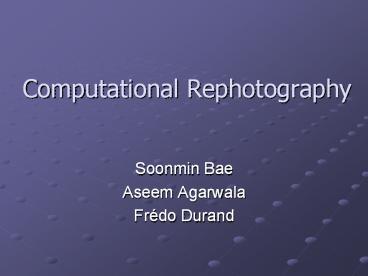Computational Rephotography - PowerPoint PPT Presentation
Title:
Computational Rephotography
Description:
Computational Rephotography Soonmin Bae Aseem Agarwala Fr do Durand What is Rephotography The act of repeat photography of the same site wikipedia Visualize ... – PowerPoint PPT presentation
Number of Views:62
Avg rating:3.0/5.0
Title: Computational Rephotography
1
Computational Rephotography
- Soonmin Bae
- Aseem Agarwala
- Frédo Durand
2
What is Rephotography
- The act of repeat photography of the same site
wikipedia - Visualize changes over time
- Changes of a city or buildings
- Effects of erosion
- Need to decide
- viewpoint
- season and time of day
- cameras and lenses
3
Newyork changingby Douglas Levere (New York City
photographer)
Custon house statues and New york produce
exchange, Manhattan, 1936
Roadway to the Battery, Manhattan, 1938 and 1997
Native American museum statues and MTA
headquarters, Manhattan, 1997
4
Urban Life though Two Lenses - 1890 and 2002
5
Goals
- Make rephotography easy
- lead photographers to choosing a desired
viewpoint matching that of a given image - Visualize the difference between a given image
and the current scene - show how to translate and rotate the camera
- Interact with users in a real time
6
Related work
- Depth (or shape) from stereo
- estimate a 3D structure from two images using
triangulation - find pairs of corresponding image points and
measure the difference to infer its depth - Panoramic mosaic
- increase FOV
- use image-warping with homography (reprojection)
- Visual homing
- lead a robot to a desired positions and
orientations - Recover the epipolar geometry relating the
current image taken by the robot and the target
image
7
Background
- Homography
- defines a geometric relation between two images
- Epipolar geometry
- find the geometric relation (homography) between
two images of a single 3D scene - SIFT (scale-invariant feature transform) Lowe
04 - extract distinctive features from images
- the features are invariant to image scale,
rotation, and partially invariant to changing
viewpoints, change in illumination - SURF (speeded up robust features)
8
Our Approach
- find and match distinctive features of a given
image and the scene - using Computer vision techniques (e.g., SIFT and
SURF) - compute the amount of translation
- using epipolar geometry
- interact with users in a real time and lead to a
desired viewpoint - using visualization
- resolve rotation
- using image warping with homographies
- or lead users to rotating the camera































